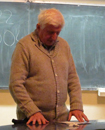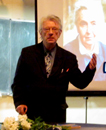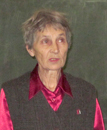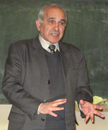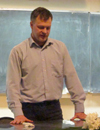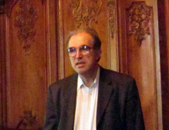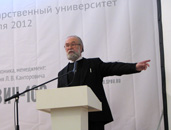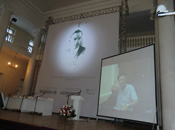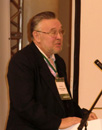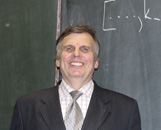2013 MEETINGS
June 11, 2013
Stephen Wolfram.
Computation and the Future of Mathematics.
June 3, 2013
Yu. I. Manin (MPIM, Bonn and Steklov Math Institute, Moscow).
Kolmogorov complexity as energy: two statistical mechanics models in informatics.
May 21, 2013
M. Tsfasman, A. Zykin (Moscow). Mathematical landscape of
Moscow: science and education.
May 14, 2013
Meeting dedicated to the 100th anniversary of Pal Erdos (1913 -
1996).
May 7, 2013
D. Grigoriev (MPIM, Bonn and CNRS, Lille). P-NP problem and
complexity of computer algebra problems.
April 23, 2013
D.Zaporozhets. Zeroes of random polynomials and analytical
functions.
April 17, 2013
Meeting dedicated to the memory of Mikhail Birman
(1928–2009).
Speakers: T.A. Suslina, A.M.Vershik, D.R.Yafaev, N.N.Uraltseva,
N.D.Filonov.
February 26, 2013

|
Meeting dedicated to the memory of the academician
Olga Ladyzhenskaya (1922 - 2004), the Society president
in 1990-1998.
|
Speakers: A Nazarov, A. Vershik, V. Solonnikov,
V. Babich, N. Ivochkina, P. Mkrtychan, T. Shilkin.
February 11, 2013
Joint meeting of three SPb seminars and of the Society dedicated
to the memory of Mikhail Birman
(on the occasion of his 85th anniversary).
T.A. Suslina. On mathematical works of M.Birman.
2012 MEETINGS
December 25, 2012
Talks by the «Young Mathematician» Society Prize for 2012 laureates.

|
A.S.Ananyevskiy. SL-oriented cohomology theories.
|

|
R.S.Pusev. Small deviations of the Green Gaussian processes in the
L2-norm.
|
December 18, 2012
G. I. Sinkevich.
Georg Cantor from St. Petersburg.
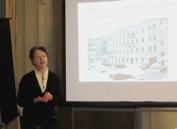
|
Recent archive research allowed us to recover the early biography and
history of G.Cantor's family.
Three generations of his family lived in St. Petersburg and were closely
connected with its culture, science, and trade. What reasons impelled
Catherine II, Paul I, and Alexander I to patronize the family?
The members of Cantor's family contributed to the creation of St.
Petersburg's culture of the XIX century.
Georg Cantor was born in the house that stood on the 11th Line of the
Vasilievsky Island and attended a school on the Nevsky avenue. He continued to
remember remarkable Petersburg when he lived in Germany, and he dreamed to
return to Russia in the end of his life.
The digitized version of the book
Georg Cantor & Polish school of set
theory by G.Sinkevich (in Russian).
|
November 1, 2012
Meeting dedicated to the 100th anniversary of A.D.Alexandrov
(1912-1999).
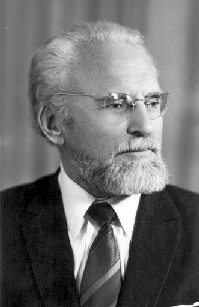
|
Speakers: A.M.Vershik, Yu.D.Burago, A.L.Verner, V.P.Odynets,
A.I.Nazarov, S.S.Kutateladze, and reminescences by
V.A.Zalgaller.
«Young Mathematician» society prize for 2012 yas been delivered to
A..S.Ananievsky and R.S.Pusev.
|
October 9, 2012
Yu. V. Matiyasevich.
Alan Turing and number theory
(to the centenary of Alan Turing's birth)
June 19, 2012

|
O.N. German (Moscow). Klein polihedra and Oppenheim
conjecture for linear forms.
|
May 22, 2012.
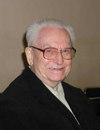
|
Meeting dedicated to the memory of N.A. Shanin
(1919–2011).
Speakers: G.E.Mints, A.O.Slissenko, V.P.Orevkov, I.M.Davydova,
N.K.Kosovskii, V.Chernov, S.Soloviev, E.F.Karavaev, Yu.V.Matiyasevich.
Video with N.A.Shanin has been shown.
|
April 24, 2012
A meeting dedicated to organizational matters.
Reports by President
Yu.V.Matiyasevich,
and Treasurer B.Lurie, the Auditing Commission chairman
A.Zaitsev have been presented.
New bodies of the Society have been elected.
A film about Yu.I.Manin by Agnes Handwerk and Harrie Willems has been shown.
March 6, 2012
Talks by the "Young Mathematician" Society Prize for 2011
laureates.
Yu. Belov. Systems of reproducing kernels in the de Branges
spaces.
F. Petrov. Limit forms for the Young diagrams and other
geometrical configurations.
February 9, 2012
A joint meeting of the Society,
and the conference «
Mathematics, Economic Sciences, and Management: the Centenary of L.V. Kantorovich
»
Reminiscences about Leonid Kantorovich (1912–1986)
A new film about L.Kantorovich has been shown.
The following speakers have participated in the meeting:
J.V.Romanovsky,, N.V. Paenson, N.A. Karaseva,
L.I. Gorkov, V.P. Odinets, I.N. Shchepina, and
V.F. Demyanov.
2011 MEETINGS
December 27, 2011
A. Razborov (Moscow, Chicago). Flag algebras.
December 13, 2011
E. Troitskii (Moscow). Reidemeister classes: algebra,
geometry, and analysis.
November 8, 2011.
Meeting dedicated to the 200-th anniversary of Évariste Galois
(1811 – 1832).
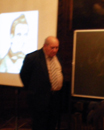
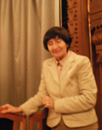
|
Talks by N.S. Ermolaeva and B.B. Lurie have been presented.
|
October 4, 2011.
Alexander Mednykh (Novosibirsk).
Geometry of knots and links.
September 13, 2011.
Jaakko Hintikka (Boston University).
Continuum hypothesis as a model-theoretical problem.
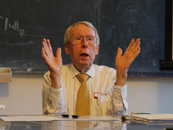
|
CH is approached as a problem about the cardinality of the second
number class ç. For the purpose, the theory of constituents is
extended to the countably infinite case where the nodes of a
constituent tree are sequences of finite constituents. Certain
branches ("perfect" ones) specify the structures of which a model
of a countably infinite constituent consists. In the case of ç,
these branches keep on splitting indefinitely and hence have the
cardinality of the continuum. Since ç is maximal, they are all
satisfied in it.
See
a detailed text of the talk.
|
July 5, 2011.
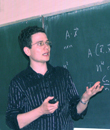
|
Mark Braverman (Toronto).
Information and interactive communication.
Notions of entropy and information, pioneered by Shannon, have been
very powerful tools in coding theory. Coding theory aims to solve the
problem of one-way communication: sending a message from Alice to Bob
using as little communication as possible, sometimes over a noisy
channel.
We will discuss several extensions of information-theoretic notions to
the two-way communication setting. We use them to prove a direct sum
theorem for randomized communication complexity, showing that
implementing k copies of a functionality requires substantially more
communication than just one copy.
More generally, we will show that information cost I(f) can be defined
as a natural fundamental property of a functionality f. We will
describe several new tight connections between I(f), direct sum
theorems, interactive compression schemes, and amortized communication
complexity.
|
June 21, 2011.
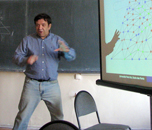
|
O. Musin (Texas and Moscow).
A generalization to manifolds of Schperner's and Tucker's lemmas and of the
Borsuk-Ulam theorem.
|
May 24, 2011
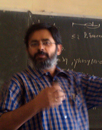
|
B. Sury (Bangalor). Diophantine equations of the form
f(x)=g(y).
Questions on counting usually involve finding integer
solutions x,y of equations of the form f(x)=g(y) for
polynomials f,g with integer or rational coefficients.
For instance, if a,b,c are rational and ab is non-zero,
then for m>n>2, the Diophantine equation
a Cmx + b Cny = c has only finitely many
integer solutions x,y. Another natural example comes from counting
lattice points in generalized octahedra. The number of integral
points on the n-dimensional octahedron
|x1| + |x2| + ... + |xn| ≤ r
is given by the polynomial expression
pn(r) = ∑i=0n 2i
CinCir
and the question of whether two octahedra of different dimensions
m,n can contain the same number of integral points becomes
equivalent to the
solvability of pm(x)=pn(y) in integers x,y.
It turns out that when m>n>1, the above equation has only finitely many
integral solutions.
The above results and many others appearing in the last decade have
been made possible by a beautiful theorem of Yuri Bilu & Robert
Tichy from 2000. For an absolutely irreducible polynomial
F(x,y)
in ℤ[x,y], a celebrated 1929 theorem due to Siegel shows
the finiteness of the number of integer solutions of
F(x,y)=0
except when the (projective completion of the) curve defined by
F(x,y)=0 has genus 0 and has at most 2 points at infinity. This
theorem generalizes also to S-integers in algebraic number fields.
But, Siegel's theorem is ineffective. Bilu & Tichy obtained for the
equation f(x)=g(y) with f,g polynomials over ℚ, a
remarkable theorem which makes Siegel's theorem much more explicit
(although still ineffective). Here, we discuss some Diophantine
equations where Bilu-Tichy theorem applies and some others where
elementary methods or methods of the Chebotarev density theorem
apply.
|
May 10, 2011
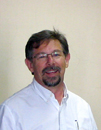
|
Gaven Martin (Auckland, New Zealand).
The governing PDE's for nonlinear material's science,
conformal geometry and the Hilbert-Smith Conjecture.
The governing equations for the theories of conformal geometry and
nonlinear materials science are basically the same and have been much
studied for centuries. Despite some significant advances in the theory
of these nonlinear elliptic equations there is still much to be
considered. Here we discuss a little of what is known about these
equations leading to a fascinating connection with Hilbert's fifth
problem on Lie groups.
This talk will cover a broad sweep of modern mathematical ideas and
connections between analysis, PDE, geometry, algebra and group theory
painted with a broad brush.
|
March 15, 2011
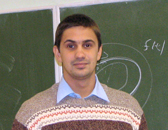
|
A talk by the Society "Young Mathematician" Prize for 2009 laureate
S. Tikhomirov. Structural stability of vector fields with shadowing property corresponding to
some reparametrization classes.
|
March 3, 2011
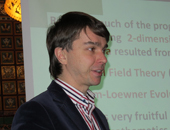
|
A talk by the Fields Prize laureate for 2010
Stanislav Smirnov (Geneva University and St. Petersburg
University). Conformal field theory and Shramm–Loewner
evolution.
Slides
|
January 18, 2011
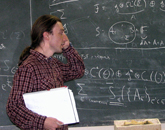
|
A talk by the Society "Young Mathematician" Prize for 2010 laureate
P. Mnev. Discrete topological quantum field theory.
|




